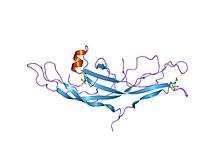CGB7
Choriogonadotropin subunit beta is a protein that in humans is encoded by the CGB7 gene.[2][3]
This gene is a member of the glycoprotein hormone beta chain family and encodes the beta 7 subunit of chorionic gonadotropin (CG). Glycoprotein hormones are heterodimers consisting of a common alpha subunit and a unique beta subunit which confers biological specificity. CG is produced by the trophoblastic cells of the placenta and stimulates the ovaries to synthesize the steroids that are essential for the maintenance of pregnancy. The beta subunit of CG is encoded by 6 genes which are arranged in tandem and inverted pairs on chromosome 19q13.3 and contiguous with the luteinizing hormone beta subunit gene.[3]
References
Further reading
- Morgan FJ, Birken S, Canfield RE (1975). "The amino acid sequence of human chorionic gonadotropin. The alpha subunit and beta subunit". J. Biol. Chem. 250 (13): 5247–58. PMID 1150658.
- Bo M, Boime I (1992). "Identification of the transcriptionally active genes of the chorionic gonadotropin beta gene cluster in vivo". J. Biol. Chem. 267 (5): 3179–84. PMID 1371113.
- Beebe JS, Mountjoy K, Krzesicki RF, et al. (1990). "Role of disulfide bond formation in the folding of human chorionic gonadotropin beta subunit into an alpha beta dimer assembly-competent form". J. Biol. Chem. 265 (1): 312–7. PMID 1688430.
- Weisshaar G, Hiyama J, Renwick AG (1992). "Site-specific N-glycosylation of human chorionic gonadotrophin--structural analysis of glycopeptides by one- and two-dimensional 1H NMR spectroscopy". Glycobiology. 1 (4): 393–404. doi:10.1093/glycob/1.4.393. PMID 1820200.
- Policastro PF, Daniels-McQueen S, Carle G, Boime I (1986). "A map of the hCG beta-LH beta gene cluster". J. Biol. Chem. 261 (13): 5907–16. PMID 2422163.
- Jameson JL, Lindell CM, Habener JF (1986). "Evolution of different transcriptional start sites in the human luteinizing hormone and chorionic gonadotropin beta-subunit genes". DNA. 5 (3): 227–34. doi:10.1089/dna.1986.5.227. PMID 2424697.
- Otani T, Otani F, Krych M, et al. (1988). "Identification of a promoter region in the CG beta gene cluster". J. Biol. Chem. 263 (15): 7322–9. PMID 2452822.
- Jameson JL, Lindell CM (1989). "Isolation and characterization of the human chorionic gonadotropin beta subunit (CG beta) gene cluster: regulation of transcriptionally active CG beta gene by cyclic AMP". Mol. Cell. Biol. 8 (12): 5100–7. PMC 365611
 . PMID 2468994.
. PMID 2468994.
- Carlsen RB, Bahl OP, Swaminathan N (1973). "Human chorionic gonadotropin. Linear amino acid sequence of the beta subunit". J. Biol. Chem. 248 (19): 6810–27. PMID 4795659.
- Julier C, Weil D, Couillin P, et al. (1984). "The beta chorionic gonadotropin-beta luteinizing gene cluster maps to human chromosome 19". Hum. Genet. 67 (2): 174–7. doi:10.1007/BF00272995. PMID 6204923.
- Talmadge K, Boorstein WR, Vamvakopoulos NC, et al. (1985). "Only three of the seven human chorionic gonadotropin beta subunit genes can be expressed in the placenta". Nucleic Acids Res. 12 (22): 8415–36. doi:10.1093/nar/12.22.8415. PMC 320381
 . PMID 6209613.
. PMID 6209613.
- Talmadge K, Boorstein WR, Fiddes JC (1984). "The human genome contains seven genes for the beta-subunit of chorionic gonadotropin but only one gene for the beta-subunit of luteinizing hormone". DNA. 2 (4): 281–9. doi:10.1089/dna.1983.2.281. PMID 6319099.
- Talmadge K, Vamvakopoulos NC, Fiddes JC (1984). "Evolution of the genes for the beta subunits of human chorionic gonadotropin and luteinizing hormone". Nature. 307 (5946): 37–40. doi:10.1038/307037a0. PMID 6690982.
- Fiddes JC, Goodman HM (1980). "The cDNA for the beta-subunit of human chorionic gonadotropin suggests evolution of a gene by readthrough into the 3'-untranslated region". Nature. 286 (5774): 684–7. doi:10.1038/286684a0. PMID 6774259.
- Mise T, Bahl OP (1981). "Assignment of disulfide bonds in the beta subunit of human chorionic gonadotropin". J. Biol. Chem. 256 (13): 6587–92. PMID 7240231.
- Birken S, Fetherston J, Canfield R, Boime I (1981). "The amino acid sequences of the prepeptides contained in the alpha and beta subunits of human choriogonadotropin". J. Biol. Chem. 256 (4): 1816–23. PMID 7462224.
- Lunardi-Iskandar Y, Bryant JL, Zeman RA, et al. (1995). "Tumorigenesis and metastasis of neoplastic Kaposi's sarcoma cell line in immunodeficient mice blocked by a human pregnancy hormone". Nature. 375 (6526): 64–8. doi:10.1038/375064a0. PMID 7723844.
- Lapthorn AJ, Harris DC, Littlejohn A, et al. (1994). "Crystal structure of human chorionic gonadotropin". Nature. 369 (6480): 455–61. doi:10.1038/369455a0. PMID 8202136.
- Bellet D, Lazar V, Bièche I, et al. (1997). "Malignant transformation of nontrophoblastic cells is associated with the expression of chorionic gonadotropin beta genes normally transcribed in trophoblastic cells". Cancer Res. 57 (3): 516–23. PMID 9012484.
PDB gallery |
|---|
|
| 1hcn: STRUCTURE OF HUMAN CHORIONIC GONADOTROPIN AT 2.6 ANGSTROMS RESOLUTION FROM MAD ANALYSIS OF THE SELENOMETHIONYL PROTEIN |
| 1hrp: CRYSTAL STRUCTURE OF HUMAN CHORIONIC GONADOTROPIN |
| 1qfw: TERNARY COMPLEX OF HUMAN CHORIONIC GONADOTROPIN WITH FV ANTI ALPHA SUBUNIT AND FV ANTI BETA SUBUNIT |
|
|

 . PMID 2468994.
. PMID 2468994. . PMID 6209613.
. PMID 6209613.

